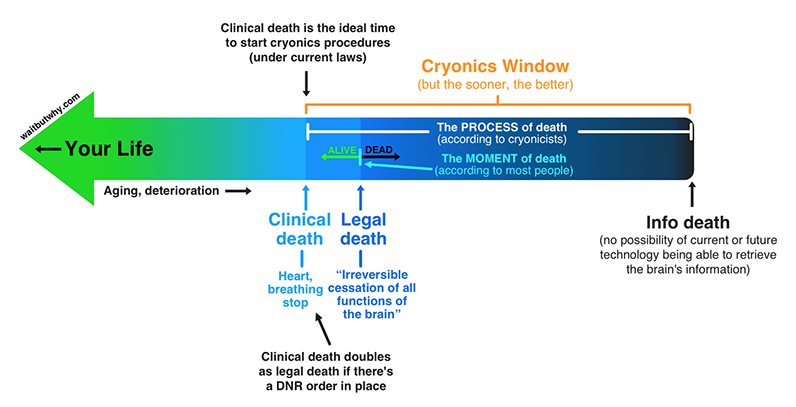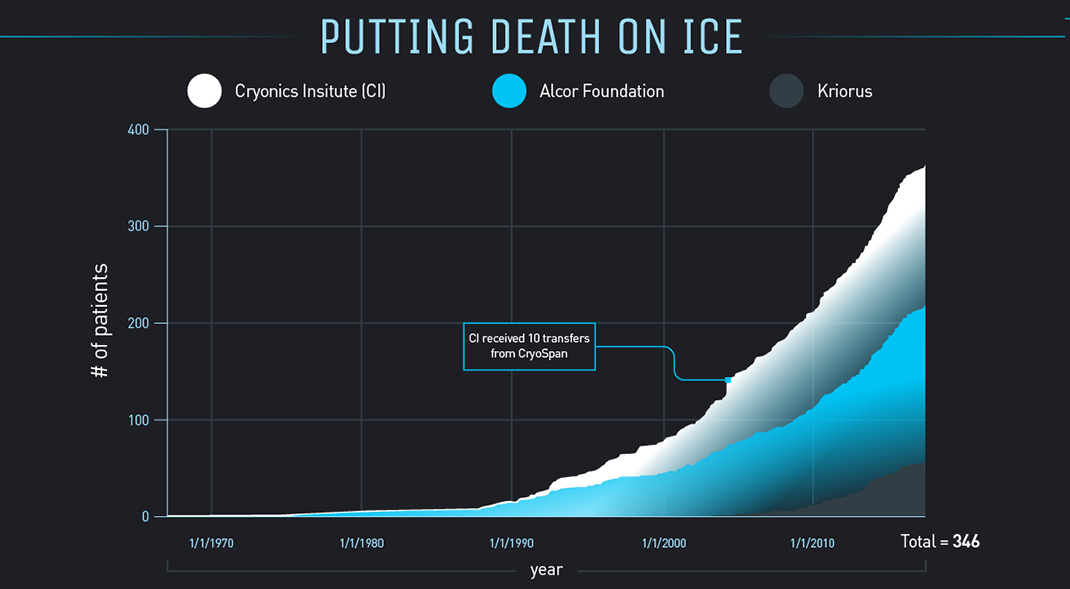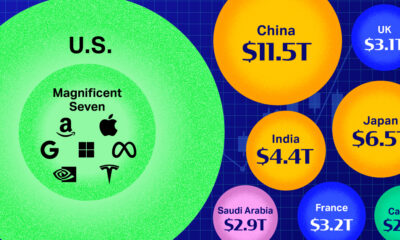Technology
Cryonics: Putting Death on Ice

Cryonics: Putting Death on Ice
There is a potent thread winding its way through generations of human culture. From Ancient Egyptian rituals to Kurzweil’s Singularity, many paths have sprung up leading to the same elusive destination: immortality.
Today, the concept is as popular as it’s ever been, and technological advances are giving people hope that immortality, or at very least radical life extension, may be within reach. Is modern technology advanced enough to give people a second chance through cryonics?
Today’s infographic, courtesy of Futurism, tackles our growing fascination with putting death on ice.
The Prospect of Immortality
Robert C. W. Ettinger’s seminal work, The Prospect Of Immortality, detailed many of the scientific, moral, and economic implications of cryogenically freezing humans for later reanimation. It was after that book was published in 1962 that the idea of freezing one’s body after death began to take hold.
One of the most pressing questions is, even if we’re able to revive a person who has been cryogenically preserved, will the person’s memories and personality remain intact? Ettinger posits that long-term memory is stored in the brain as a long-lasting structural modification. Basically, those memories will remain, even if the brain’s “power is turned off”.
Descending into the Deep-Freeze
There are three main steps in the cryogenic process:
1) Immediately after a patient dies, the body is cooled with ice packs and transported to the freezing location.
2) Next, blood is drained from the patient’s body and replaced with a cryoprotectant (basically the same antifreeze solution used to transport organs destined for transplant).
3) Finally, once the body arrives at the cryonic preservation facility, the body is cooled to -196ºC (-320.8ºF) over the course of two weeks. Bodies are generally stored upside-down in a tank of liquid nitrogen.
The Economics of Cryopreservation
At prices ranging from about $30,000 to $200,000, cryopreservation may sound like an option reserved for the wealthy, but many people fund the procedure by naming a cryonics company as the primary benefactor of their life insurance policy. Meanwhile, in the event of a death that doesn’t allow for preservation of the body, the money goes to secondary beneficiaries.
Even if we do eventually find a way to reanimate frozen humans, another important consideration is how those people would take care of themselves financially. That’s where a cryonics or personal revival trust comes into play. A twist on a traditional dynastic trust, this arrangement ensures that there are funds to cover costs of the cryopreservation, as well as ensure the grantor would have assets when they’re unthawed. Of course, there are risks involved beyond the slim possibility of reanimation. The legal code in hundreds of years could be vastly different than today.
If you created a trust for specific purposes in 1711, it is unlikely it would function in the same way today.
– Kris Knaplund, Law Professor, Pepperdine University
Cold Humans, Hot Market
At last count, there are already 346 people in the deep freeze, with thousands more on the waiting list. As technology improves, those numbers are sure to continue rising.
Time will tell whether cryonically preserved people are able to cheat death. In the meantime? The cryonics industry is alive and well.
Technology
Ranked: Semiconductor Companies by Industry Revenue Share
Nvidia is coming for Intel’s crown. Samsung is losing ground. AI is transforming the space. We break down revenue for semiconductor companies.
Semiconductor Companies by Industry Revenue Share
This was originally posted on our Voronoi app. Download the app for free on Apple or Android and discover incredible data-driven charts from a variety of trusted sources.
Did you know that some computer chips are now retailing for the price of a new BMW?
As computers invade nearly every sphere of life, so too have the chips that power them, raising the revenues of the businesses dedicated to designing them.
But how did various chipmakers measure against each other last year?
We rank the biggest semiconductor companies by their percentage share of the industry’s revenues in 2023, using data from Omdia research.
Which Chip Company Made the Most Money in 2023?
Market leader and industry-defining veteran Intel still holds the crown for the most revenue in the sector, crossing $50 billion in 2023, or 10% of the broader industry’s topline.
All is not well at Intel, however, with the company’s stock price down over 20% year-to-date after it revealed billion-dollar losses in its foundry business.
| Rank | Company | 2023 Revenue | % of Industry Revenue |
|---|---|---|---|
| 1 | Intel | $51B | 9.4% |
| 2 | NVIDIA | $49B | 9.0% |
| 3 | Samsung Electronics | $44B | 8.1% |
| 4 | Qualcomm | $31B | 5.7% |
| 5 | Broadcom | $28B | 5.2% |
| 6 | SK Hynix | $24B | 4.4% |
| 7 | AMD | $22B | 4.1% |
| 8 | Apple | $19B | 3.4% |
| 9 | Infineon Tech | $17B | 3.2% |
| 10 | STMicroelectronics | $17B | 3.2% |
| 11 | Texas Instruments | $17B | 3.1% |
| 12 | Micron Technology | $16B | 2.9% |
| 13 | MediaTek | $14B | 2.6% |
| 14 | NXP | $13B | 2.4% |
| 15 | Analog Devices | $12B | 2.2% |
| 16 | Renesas Electronics Corporation | $11B | 1.9% |
| 17 | Sony Semiconductor Solutions Corporation | $10B | 1.9% |
| 18 | Microchip Technology | $8B | 1.5% |
| 19 | Onsemi | $8B | 1.4% |
| 20 | KIOXIA Corporation | $7B | 1.3% |
| N/A | Others | $126B | 23.2% |
| N/A | Total | $545B | 100% |
Note: Figures are rounded. Totals and percentages may not sum to 100.
Meanwhile, Nvidia is very close to overtaking Intel, after declaring $49 billion of topline revenue for 2023. This is more than double its 2022 revenue ($21 billion), increasing its share of industry revenues to 9%.
Nvidia’s meteoric rise has gotten a huge thumbs-up from investors. It became a trillion dollar stock last year, and broke the single-day gain record for market capitalization this year.
Other chipmakers haven’t been as successful. Out of the top 20 semiconductor companies by revenue, 12 did not match their 2022 revenues, including big names like Intel, Samsung, and AMD.
The Many Different Types of Chipmakers
All of these companies may belong to the same industry, but they don’t focus on the same niche.
According to Investopedia, there are four major types of chips, depending on their functionality: microprocessors, memory chips, standard chips, and complex systems on a chip.
Nvidia’s core business was once GPUs for computers (graphics processing units), but in recent years this has drastically shifted towards microprocessors for analytics and AI.
These specialized chips seem to be where the majority of growth is occurring within the sector. For example, companies that are largely in the memory segment—Samsung, SK Hynix, and Micron Technology—saw peak revenues in the mid-2010s.
-

 Markets2 weeks ago
Markets2 weeks agoAmerica’s Top Companies by Revenue (1994 vs. 2023)
-

 Environment1 week ago
Environment1 week agoRanked: Top Countries by Total Forest Loss Since 2001
-

 Real Estate1 week ago
Real Estate1 week agoVisualizing America’s Shortage of Affordable Homes
-

 Maps2 weeks ago
Maps2 weeks agoMapped: Average Wages Across Europe
-

 Mining2 weeks ago
Mining2 weeks agoCharted: The Value Gap Between the Gold Price and Gold Miners
-

 Demographics2 weeks ago
Demographics2 weeks agoVisualizing the Size of the Global Senior Population
-

 Automotive2 weeks ago
Automotive2 weeks agoTesla Is Once Again the World’s Best-Selling EV Company
-

 Technology2 weeks ago
Technology2 weeks agoRanked: The Most Popular Smartphone Brands in the U.S.













